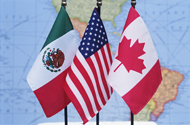
10 Years of NAFTA:
What Impact on Trade?
Itís been 10 years since the North American Free Trade Agreement (NAFTA) marked a major milestone in the liberalization of U.S. trade policy. While the United States had previously negotiated limited preferential trade arrangements with its NAFTA partners, Mexico and Canada, the 1994 pact broadened the product coverage and strengthened the rules and procedures governing trade and investment on the North American continent.
NAFTA continues to be controversial, with opponents saying it has failed to live up to its promises of job creation. Proponents, on the other hand, laud NAFTA for boosting U.S. exports.
Since NAFTA, U.S. exports to Canada, and particularly to Mexico, have grown far more rapidly than U.S. exports to the rest of the world in virtually every major industry group, according to the U.S. Department of Commerce. Moreover, Canada has consolidated its position as the United Statesí leading trading partner and Mexico surpassed Japan to become number two.
Furthermore, NAFTA has enabled North American firms utilizing U.S.-manufactured materials and components and lower-cost Mexican assembly facilities to compete more aggressively with low-cost, low-wage competitors, particularly in China and the newly industrializing Asian countries.
Efforts extend to Central America
U.S. trade efforts havenít stopped with NAFTA. For example, earlier this year, the Bush administration signed a free trade agreement with Costa Rica, El Salvador, Guatemala, Honduras and Nicaragua called the Central American Free Trade Agreement (CAFTA).
CAFTA will immediately eliminate tariffs on more than 80% of U.S. exports of consumer and industrial products, phasing out the remainder over a span of 10 years. The agreement marks another step toward the possible creation of a comprehensive free trade area encompassing the entire Western hemisphere.
With the pending addition of the Dominican Republic, CAFTA is the second largest U.S. export market in Latin America, behind only Mexico, buying more than $15 billion in U.S. exports annually, according to the Office of the U.S. Trade Representative. CAFTA also is an important export market for U.S. manufacturing sectors such as electronics, chemicals, food, petroleum and coal.
When evaluating international trade opportunities, look to Cole Taylor. Call us at (847) 653-7474 to learn about our export services.
Since NAFTA, U.S. exports to Canada, and particularly to Mexico, have grown far more rapidly than U.S. exports to the rest of the world in virtually every major industry group, according to the U.S. Department of Commerce.
Visit us at
www.coletaylor.com
